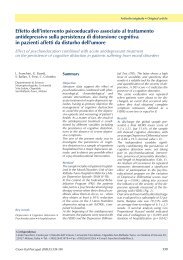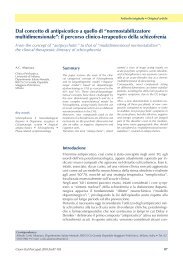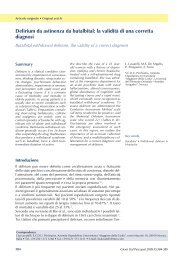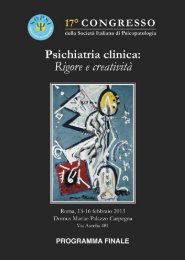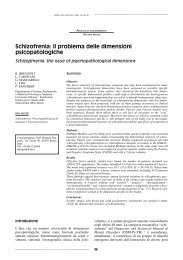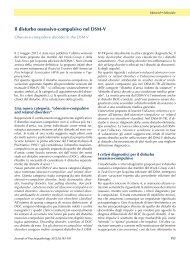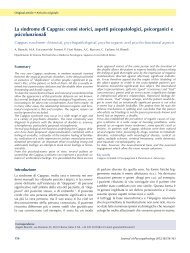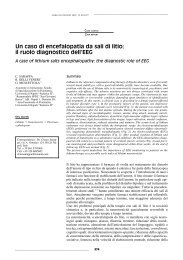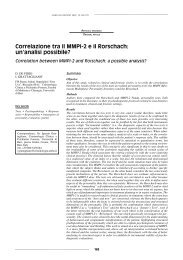XI Congresso della Società Italiana di Psicopatologia Psichiatria ...
XI Congresso della Società Italiana di Psicopatologia Psichiatria ...
XI Congresso della Società Italiana di Psicopatologia Psichiatria ...
Create successful ePaper yourself
Turn your PDF publications into a flip-book with our unique Google optimized e-Paper software.
Fig. 1.<br />
Fig. 2.<br />
tanza <strong>della</strong> psichiatria <strong>di</strong> Consultazione e Collegamento nella<br />
gestione <strong>di</strong> casi <strong>di</strong>fficili, in cui compaiano importanti variabili<br />
emozionali. Tali considerazioni chiariscono come siano<br />
in<strong>di</strong>spensabili la creazione ed il buon funzionamento <strong>di</strong><br />
un’attività <strong>di</strong> <strong>Psichiatria</strong> <strong>di</strong> Liaison.<br />
Bibliografia<br />
Rundell JR, Wise MG. La <strong>Psichiatria</strong> nella pratica me<strong>di</strong>ca. Torino:<br />
Centro Scientifico E<strong>di</strong>tore 1998.<br />
Gala C, et al. A Multicenter Investigation of Consultation-Liaison<br />
Psychiatry in Italy. Gen Hosp Psychiatry 1999;21.<br />
179. Utilizzo <strong>di</strong> quetiapina in setting acuto:<br />
decision-making da aloperidolo fiale<br />
a quetiapina compresse<br />
S. Masuzzo, R. Intorella, M. Sittinieri<br />
SPDC Ospedale Maria Paternò, Arezzi <strong>di</strong> Ragusa<br />
POSTER<br />
Introduzione: l’identificazione <strong>di</strong> schemi <strong>di</strong> switching da<br />
formulazioni iniettive <strong>di</strong> antipsicotici tipici ad atipici (in<br />
questo lavoro quetiapina), che tengano conto dell’acuzie dei<br />
pazienti e dei tempi <strong>di</strong> degenza, facilita l’impostazione <strong>di</strong><br />
trattamenti efficaci e tollerati che possano essere agevolmente<br />
continuati.<br />
Obiettivo: valutare efficacia, sicurezza e tollerabilità <strong>di</strong> uno<br />
schema <strong>di</strong> switch da aloperidolo fl. a quetiapina cpr in pz.<br />
psicotici ospedalizzati in fase <strong>di</strong> acuzie.<br />
Metodologia: pz (n. 10) con <strong>di</strong>agnosi <strong>di</strong> Disturbo Schizofrenico<br />
o Bipolare I più recente episo<strong>di</strong>o maniacale, (DSM<br />
IV TR), CGI 5, ricovero minimo 7 giorni, trattati il 1 giorno<br />
con aloperidolo fl., il 2 giorno introduzione <strong>di</strong> quetiapina, titolata<br />
a 900 mg/<strong>di</strong>e in 5 giorni, con sospensione <strong>di</strong> aloperidolo<br />
fl al 5 giorno (al 3 giorno 50% dose iniziale, 4 giorno<br />
il 25%). Efficacia valutata con BPRS, CGI, PANSS, YMRS<br />
(basale T0, 7 giorno T1 e alla <strong>di</strong>missione TD); sicurezza tol-<br />
lerabilità me<strong>di</strong>ante la rilevazione <strong>di</strong> eventi avversi e monitoraggio<br />
dei segni vitali.<br />
Risultati: miglioramento psicopatologico generale (TD vs.<br />
T0) con percentuale <strong>di</strong> miglioramento del 31,9% alla BPRS,<br />
65,4 alla CGI, 68,8% alla YMRS. Nessuna variazione dei<br />
parametri vitali, né comparsa <strong>di</strong> eventi avversi.<br />
Conclusioni: i dati in<strong>di</strong>cano che lo schema rapido <strong>di</strong> switching<br />
utilizzato (in 5 giorni, monoterapia con quetiapina<br />
900 mg/<strong>di</strong>e e sospensione <strong>di</strong> aloperidolo fiale) consente <strong>di</strong><br />
impostare già durante le prime fasi del ricovero, una terapia<br />
efficace, maneggevole e sicura.<br />
Bibliografia<br />
Chengappa. CNS Spectr 2004.<br />
180. Group II metabotropic glutamate<br />
receptor ligands-induce neurogenesis<br />
in cerebellar granular cell cultures<br />
F. Matrisciano * ** , I. Panaccione ** , B. Turriziani ** ,<br />
M. Zusso *** , P. Giusti *** , P. Girar<strong>di</strong> * , R. Tatarelli * ,<br />
D. Melchiorri ** , F.B. Nicoletti *<br />
* Department of Psychiatry and Psychological Me<strong>di</strong>cine,<br />
Sant’Andrea Hospital, University of Rome “La Sapienza”;<br />
** Department of Human Physiology and Pharmacology,<br />
University of Rome “La Sapienza”; *** Department of Pharmacology<br />
and Anesthesiology, University of Padova<br />
Introduction: metabotropic glutamate (mGlu) receptors<br />
have been recently shown to be involved in the pathophysioloy<br />
of depression. Group I and II mGlu receptors are upregulated<br />
by chronic antidepressant treatment, and exert<br />
antidepressant-like activity in several preclinical and some<br />
clinical stu<strong>di</strong>es. Antidepressant drugs induce proliferation<br />
and <strong>di</strong>fferentiation of progenitor cells in the hippocampal<br />
dentate gyrus of the adult brain. The generation of new<br />
neurons is thought to be involved in the antidepressant activity.<br />
Recently, the selective serotonin reuptake inhibitor,<br />
fluoxetine was reported to up-regulate proliferation of<br />
progenitor cells in cerebellar granular cell cultures. This<br />
fin<strong>di</strong>ng is of interest as granule cell cultures are a unique in<br />
vitro model of post-natal <strong>di</strong>fferentiating neurons. We thus<br />
examined whether treatment with selective ligands of<br />
mGlu receptors mimics the neurogenic effect of fluoxetine<br />
in mixed cultures of both progenitor and mature cerebellar<br />
granule cells.<br />
Material and Methods: primary cultures of rat cerebellar<br />
granule cells prepared from 7-day-old rat pups contain<br />
both <strong>di</strong>fferentiated granule cells and un<strong>di</strong>fferentiated precursors,<br />
the latter termed round cells. The expression of in<strong>di</strong>vidual<br />
mGlu receptor subtypes was assessed in round<br />
cells by Western Blot analyses. Ten days after plating,<br />
mixed granule cell cultures were exposed either to fluoxetine<br />
(1 µM), or to the selective group II mGlu receptor ligands<br />
LY379268 (1 µM) and LY341495 (1 µM) for 72<br />
hours. Cell proliferation was assessed following incorporation<br />
of 5-bromo-2’-deoxyuri<strong>di</strong>ne (BrdU) (10 µM) by<br />
round cells.<br />
Results: round cells, at 6-10 days in vitro (DIV) expressed<br />
mGlu2/3 and -5 receptors. Fluoxetine, the selective group<br />
II mGlu receptor agonist, LY379268, and the group II<br />
304




